Camper Van Bed Ideas for Your Conversion
Learn about different camper van bed options including platform and convertible folding van beds plus examples of each.
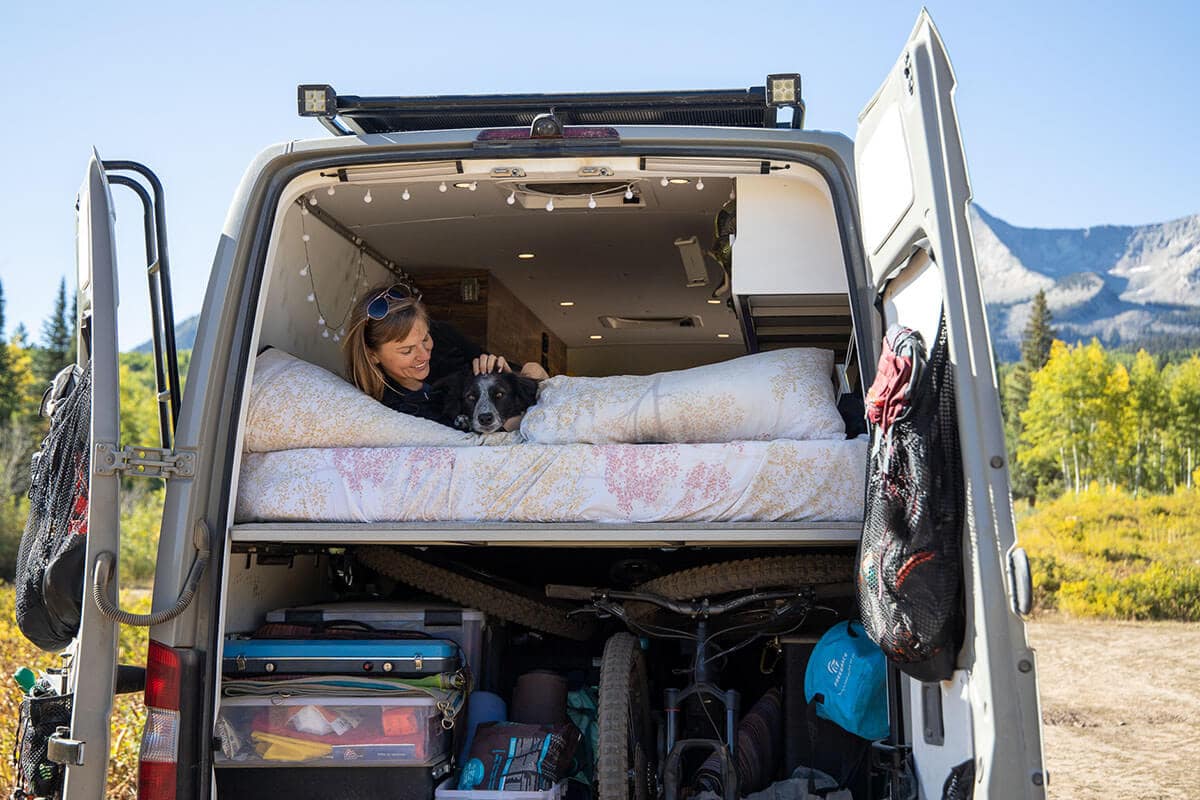
What type of camper van bed you want in your home on wheels will be one of the first decisions you’ll make in your van conversion – maybe you want a platform bed so you can store mountain bikes and other gear underneath. Or perhaps you want a convertible folding bed so you can have a table to work at during the day and a bed only at night when you need it.
In this post, I cover the pros and cons of different types of van beds, some options for utilizing your space as efficiently as possible including flares and custom mattresses, and share some campervan bed ideas to give you inspiration for your own build.
This post may contain affiliate links.
Van Bed Styles Video

Save this post!
Enter your email & I'll send this post to your inbox! You'll also receive my weekly newsletter full of helpful advice for planning your adventures.
Camper Van Bed Styles
Deciding on the type of bed you want for your van should be one of the first choices you make because the rest of the camper van layout will revolve around this. The two primary styles you’ll see in vans are a platform-style bed or a convertible bed. Here are the key differences:
- Platform beds: fixed in place and always in “bed mode”
- Convertible beds: folding van beds that can transform from couch or dinette by day to bed by night.
There are a few initial questions to consider to guide you in choosing a bed style:
- How much space do you want a bed to take up in your van?
- How big of a bed do you need? Can you sleep sideways in your van (from side to side) or do you need to sleep vertically (front to back)?
- What kind of gear do you plan to carry? Bikes, backpacking gear, paddling equipment, etc?
- Do you want to be able to store bikes or other gear that requires a lot of space under the bed?
- Are you okay with setting up and putting away a convertible bed every day?
- How much headroom do you need? Do you want to be able to sit up in bed?
- Do you want ample seating to be able to host and entertain friends in your van?
- Where will you eat? Where will you work? Where will you lounge?
In my first Sprinter, I had a convertible bed that turned into a couch/seating area during the day. I quickly realized I didn’t enjoy converting it every day, and it severely limited storage options for gear. Since exploring the outdoors via hiking, biking, paddling, and more were the main reasons I bought a van in the first place, in my second (and now third) van, I chose to have a fixed platform bed with a large “garage” for gear storage underneath the bed.
Think about what your day-to-day life and travels will look like in your van to get an idea of what will work best for you. Below I cover the pros and cons of fixed platform beds vs convertible beds along with a few different options to help you decide what’s right for you.
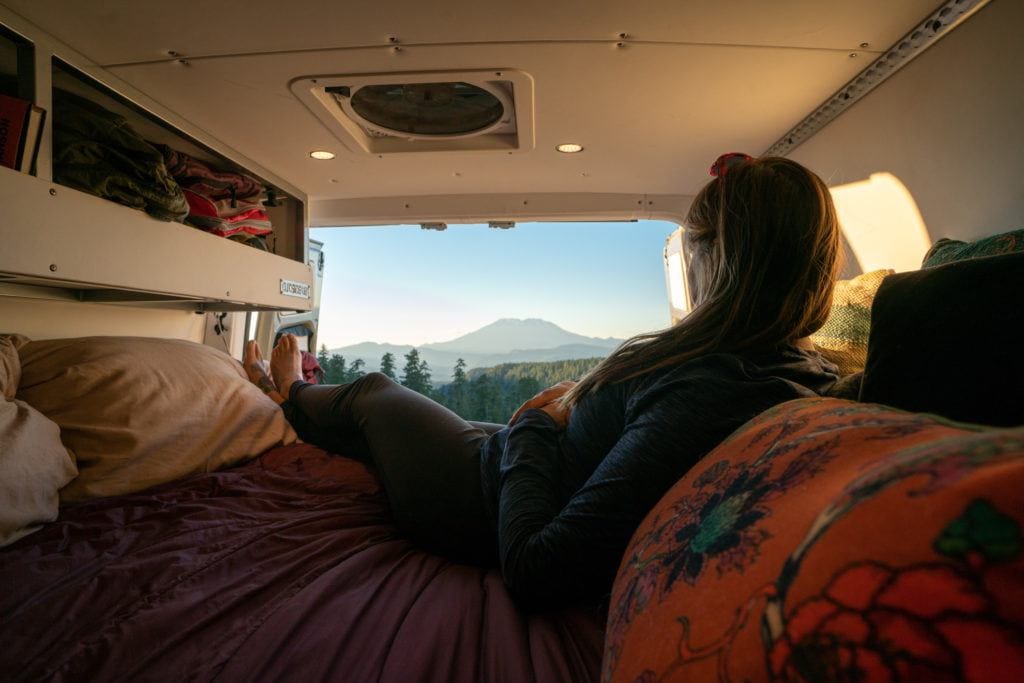
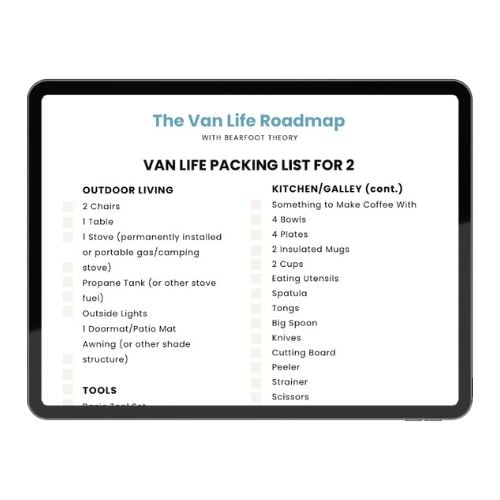
Freebie!
Van Life Packing Checklist
Get this free PDF that will help you pack up your van in a jiffy.
Fixed Platform Van Beds
Having a platform or fixed bed in your van provides ample storage underneath for bikes, gear, water tanks, a toilet – you name it. Van lifers call this area under the bed “the garage.” This is the setup and the bed I had in my second 4×4 Sprinter van.
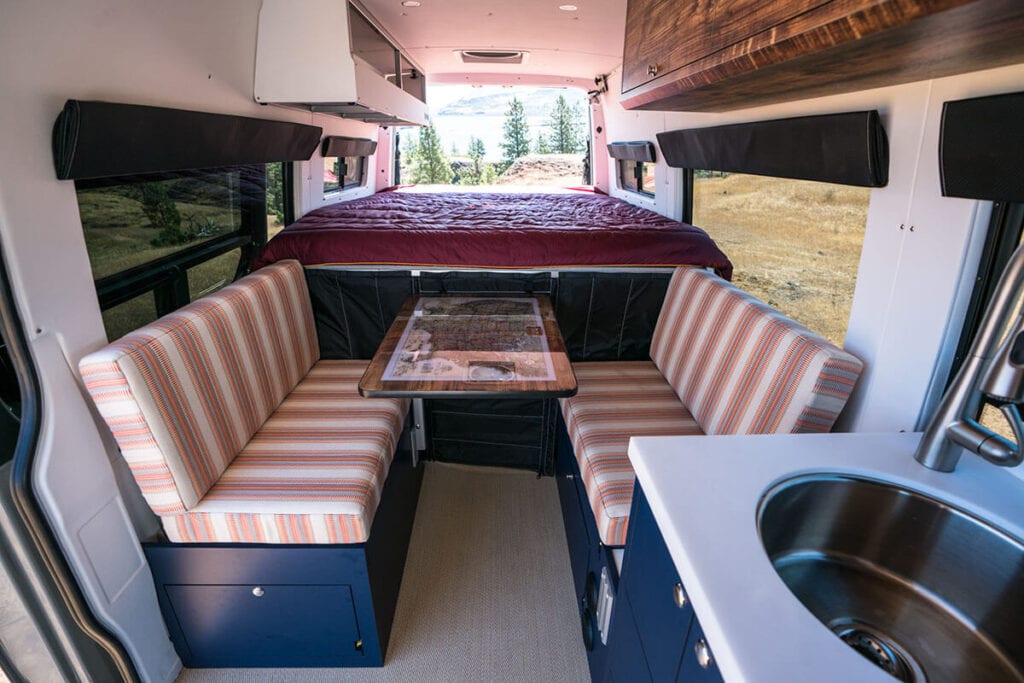

Fixed Platform Bed Pros
- Always in “bed mode” – less hassle because you don’t have to convert your bed every day/night
- Can build the bed as high as you want, creating even more storage space underneath
- Don’t need a place to store your bedding and pillows because they just stay on the bed at all times
- The overall design and build are less complicated than a convertible bed
- A fixed bed is always ready for rainy afternoon naps or after a long day on the trail
- May be able to make a regular mattress fit (likely a full or queen size), although you’ll probably have some extra space around it.
Fixed Platform Bed Cons
- Has a larger footprint in your van than a convertible bed, so you’ll need to figure out a seating area for when you’re not in bed, especially if you work from the road.
- Don’t have the flexibility to use that space for another purpose when you’re not sleeping
Platform Bed Layout and Dimensions
In the Ford Transit and Mercedes Sprinter, the width of the van once you’ve installed insulation and paneling is about 5’10”. The Dodge Promaster is slightly wider. So unless you are shorter than the width of the van or a dedicated side sleeper, you will likely want to set up your platform bed so you sleep vertically down the van (front to back), rather than horizontally (side to side). This long way’s orientation also allows for easy storage of mountain bikes under the bed since they’re a similar length.
Another option to consider if you’d like to sleep horizontally (side to side) in the van and widen your sleeping space is to install Flares. I cover this option further below.
Convertible Van Beds
There are tons of different options and layouts when it comes to convertible (or non-fixed) van beds. Typically, these are beds that need to be set up each night, and each day are converted into a seating/dinette configuration. I had a futon-style couch-to-bed setup in my first Sprinter.
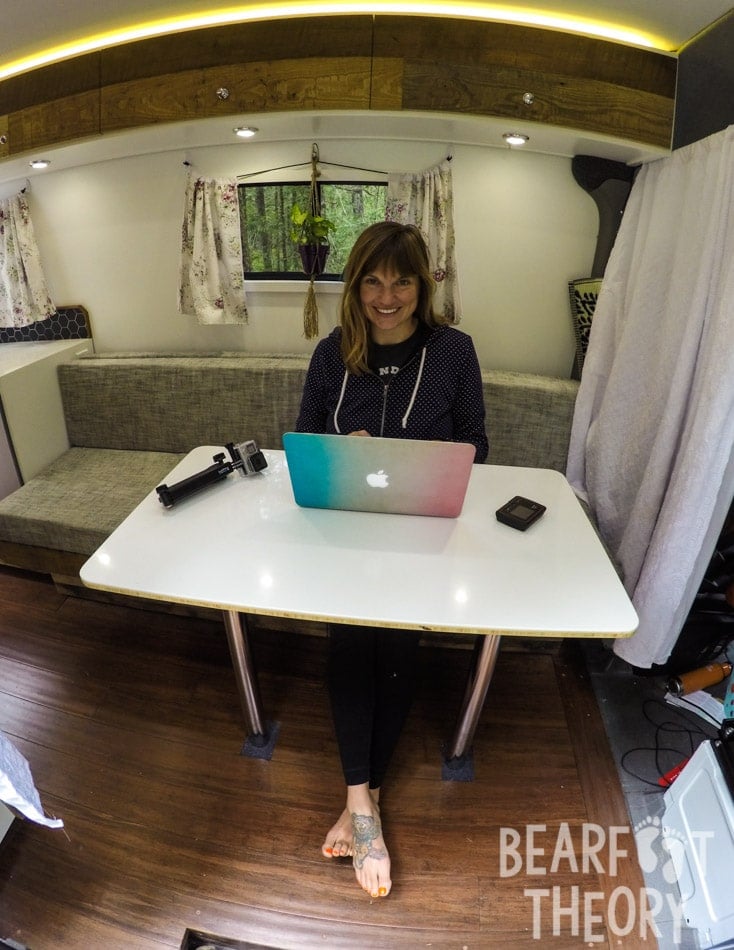
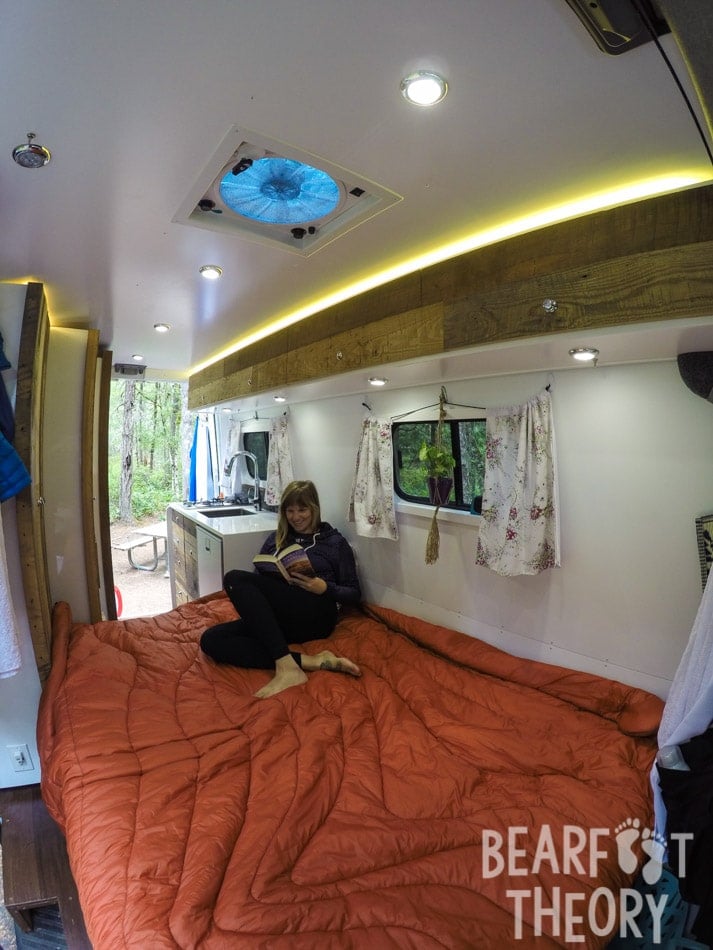
Convertible Bed Pros
- Offers more living space and serves a dual purpose. For example, if you have a dinette in the rear of the van that converts to a bed, you can seat 6 people easily at your table or have a huge workspace.
- Since the bed is often lower than a platform, it makes for nice photos out the back of the van if that’s something you care about.
Convertible Bed Cons
- It can be a hassle to set up and tear down your bed every day and you have to find a place to store your bedding during the day (unless you have a Murphy bed)
- Can’t have both a bed and dinette at the same time
- Sacrifices indoor storage space for larger gear items like bikes, inflatable paddleboards, etc.
- You typically sleep on multiple cushions, so it’s the least similar to a real mattress (unless you have a Murphy bed)
Convertible Bed Layout and Dimensions
As I mentioned before, there are tons of configurations for convertible beds – common examples are:
- Bench-to-bed: The dinette table drops down and the back cushions from the benches are used to fill in the bed. You can have an open back with 2 benches across from each other, or design a “U-shape” bench with 3 benches.
- Couch-to-bed: A small couch that slides out to convert to a flat bed
- Murphy bed: A mattress on a platform that is raised and lowered against the wall, giving you seating and a table without having to totally disassemble and reassemble your bed every time
While the folding or convertible van bed design sacrifices some storage, for example – you won’t be storing mountain bikes and bigger gear items inside the van – it makes up for it in open living space throughout the day. So if storage isn’t your top priority and you don’t mind opening and closing your bed every day this could work for you.
Van Bed Sleeping Orientation
Another thing to keep in mind as you plan your van bed and layout is what direction you plan to sleep in. Some key considerations:
- Height: Anyone over 6’0 will not be able to comfortably sleep horizontally (wall to wall) unless you install Flares
- Width of your van: Be sure to check measurements and factor in your insulation and walls. The Promaster has the widest width of popular panel vans.
- Sleep position: How do you normally sleep? Do you curl up on your side or do you like to stretch out?
Being able to sleep horizontally (wall to wall) gives you extra floor space and room in your van, but if you’re tall, you probably need to sleep vertically (head toward the back and feet toward the front).
Flares for Sleeping Sideways
If you want a platform bed and want to be able to sleep horizontally across the width of your van (rather than front to back) but you’re too tall, then you might consider installing Flares. Flares are made for Sprinters, Transits, Promasters, Ford E-Series Vans, and other types of van. When installed, they extend the width of your van in the bed area. This allows you to comfortably sleep across the van rather than down the length of the van.

By changing the orientation of your bed, you gain almost two feet lengthwise inside the van for living space that can be used to add seating, a larger galley, or even a bathroom.
If you choose to install Flares in your van, Flarespace also makes compatible bed systems, including perfectly sized mattresses and custom sheets.
The only downside of sleeping sideways across the width of the van is that if two people are sleeping in the bed, the person near the back will have to crawl over the other if they have to get up in the middle of the night to go to the bathroom. This seems like a small sacrifice to gain such a significant amount of living space in your van – and it’s one I’d consider if I was going to build another van.
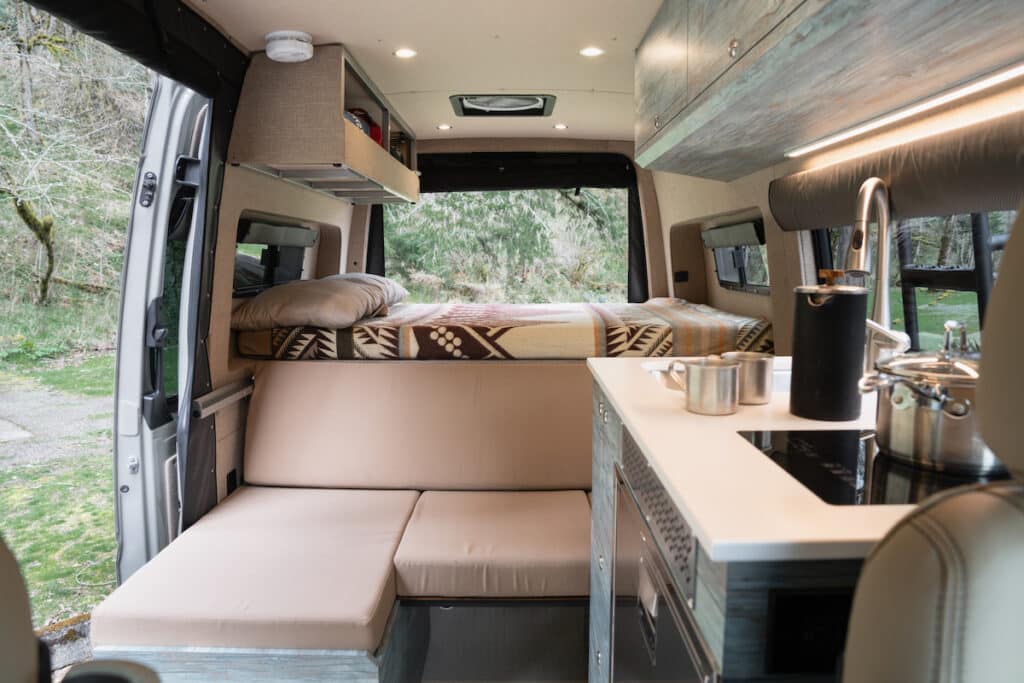
Van Mattress Options
While you may just think you can throw your mattress from home in your van, that may not be the best option. Instead of planning your van layout around your mattress, I’d recommend picking your bed style and orientation first then finding a mattress that works in your space. Remember, you’re going to be sleeping in your van bed every night, so you want to pick something that’s comfortable and durable.
Traditional Mattress
Using a mattress you already own is the easiest and cheapest option, but there are a few things to consider before tossing a standard mattress into your van. First, a traditional mattress might not easily fit in your van, especially if you’re planning on sleeping horizontally (traditional mattresses are usually longer than the width of most vans), and because of the coils, they can’t be cut to size.
Traditional mattresses are also heavier and ~12″ thick, which may leave you with not a lot of head space to sit upright in your bed, especially if you have a fixed bed with bikes stored underneath.
Foam Mattress
Foam mattresses are the most popular option, simply because they’re easy to cut to size (no coils), super comfortable, and usually the most affordable option. If you plan on DIY’ing a convertible bed, a foam mattress is the easiest way to cut your cushions to size. Foam mattresses are also usually thinner than a traditional mattress (generally 4-6″ thick, and we’ve found the sweet spot for a van mattress to be closer to 6″).
Custom Mattress
If you’re not able to find a mattress that will work with the space you have in your van, or you want to make the most of the space you have, a custom mattress is an option that can actually be pretty affordable. You can order a mattress to the exact dimension of the platform space you have in your van so you can utilize every inch, and some companies can even make mattresses with angled or notched corners in case there’s something you need to work around.
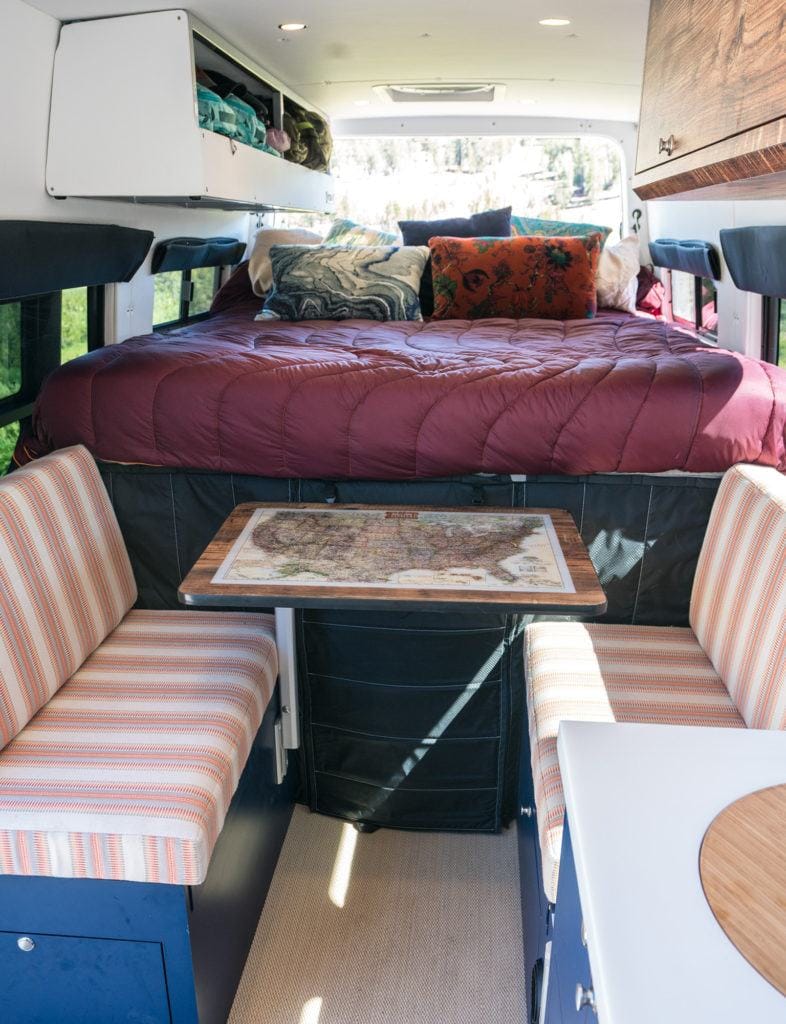
Flarespace Bed Systems
First, if you’re thinking of having flares installed on your van, Flarespace makes mattresses and bed systems that are 100% compatible with their Flares. You’ll find 5″ thick memory foam mattresses for 144″ Sprinters, Transits, and more that fit perfectly inside your Flares to maximize sleeping space. Their mattresses are made out of high-density firm soy-based foam with an organic cotton cover and are known to be super comfy.

Van Bed Layout Ideas
Now that I’ve talked through the different camper van bed styles, let’s show some examples for design inspiration for your own build:
Convertible Raised Dinette Bed
This raised dinette in @wearewanderinghome’s van offers a convertible place to sit along with a “mini-garage” underneath, perfect for storing shoes and other smaller items.

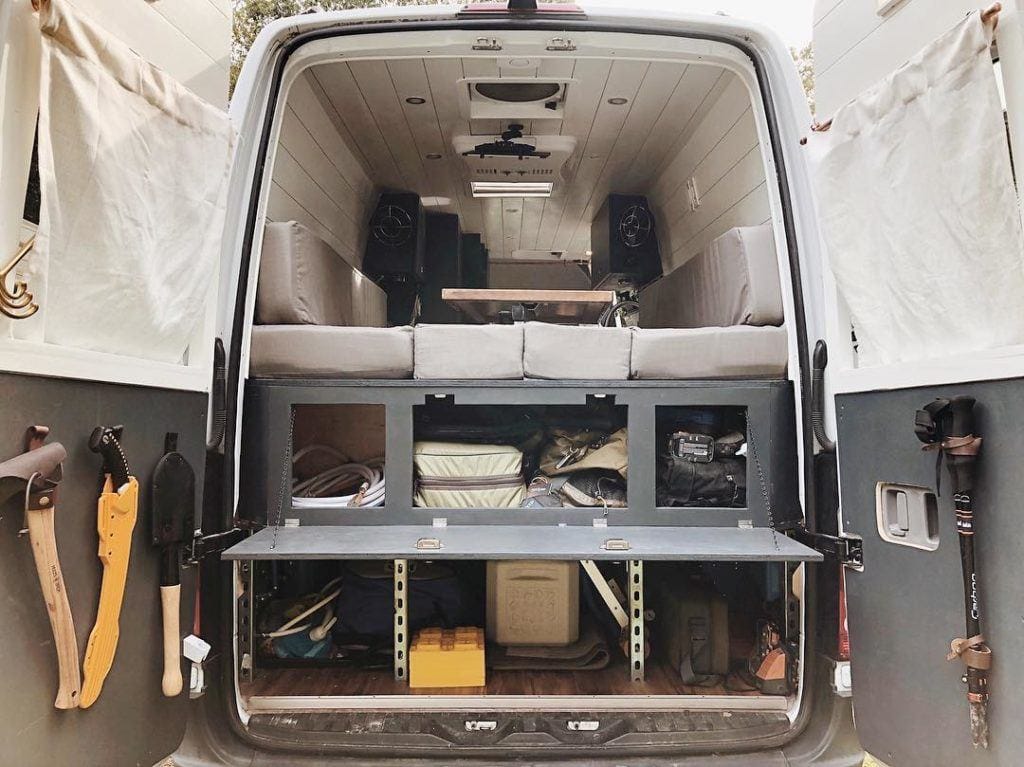
U-Shaped Raised Bench-to-Bed
This raised dinette in the back of @drivingmevananas‘s van converts into a bed and has a garage for smaller items below.
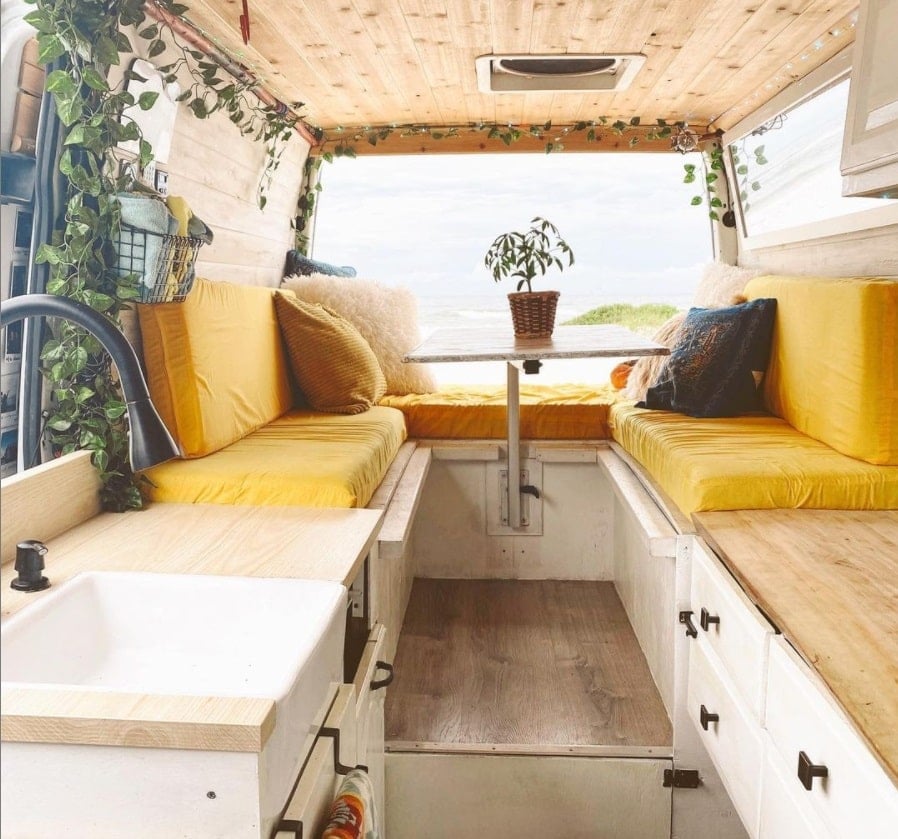

Convertible Murphy Bed (back wall)
This custom murphy convertible bed by @jarrodtocci stores in the wall when not in use and pulls down at bedtime. You can learn more about this setup in Jarrod’s Murphy Bed Video.
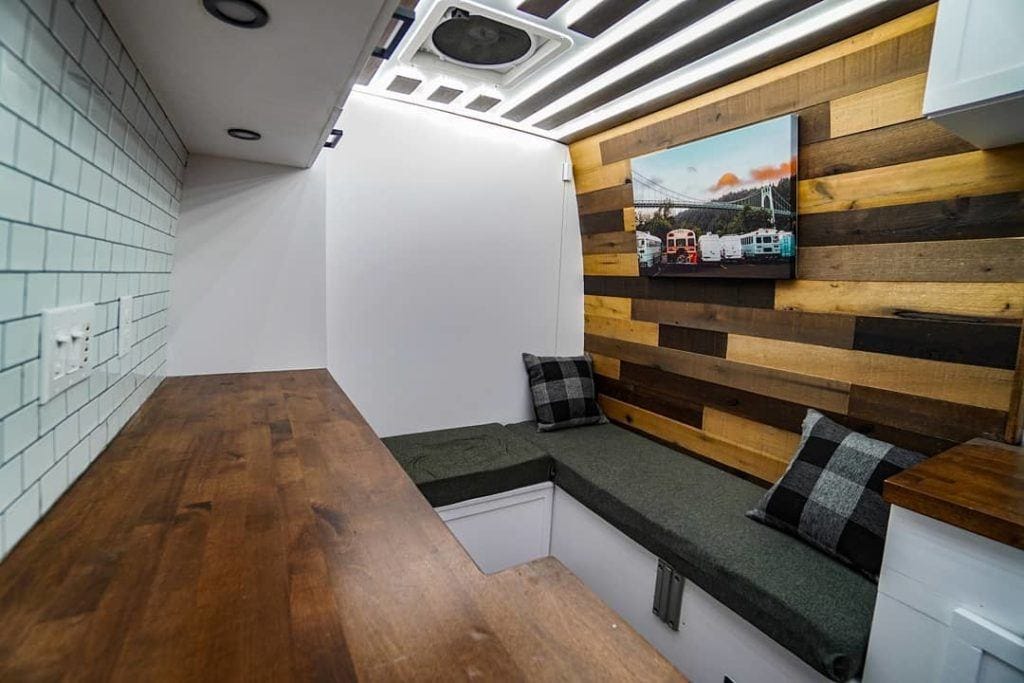
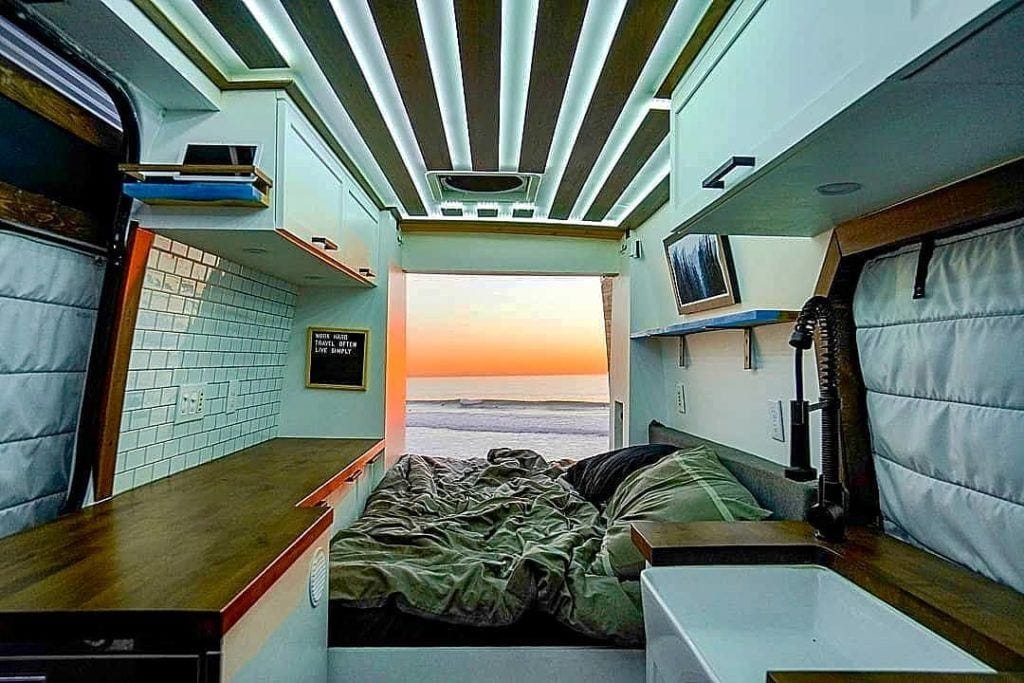
Convertible Murphy Bed (side wall)
Mariajosé & Chase of @tioaventuravan built a Murphy bed into the side wall of their van that converts into a small seating/dining area.
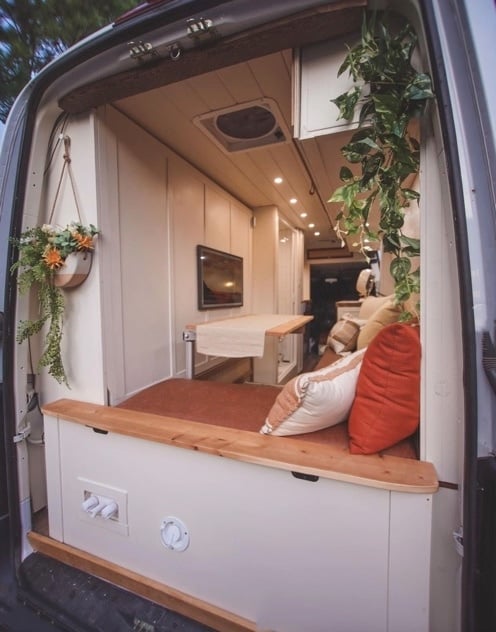

U-Shaped Bench-to-Bed
This convertible dinette and workspace in @asobolife‘s van folds into a bed with expansive views out the back.
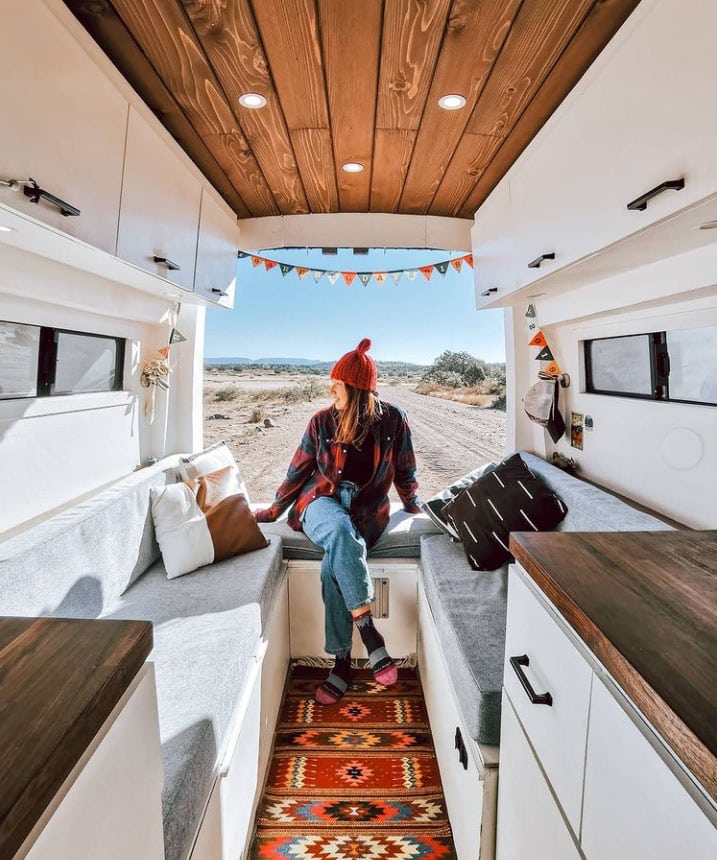
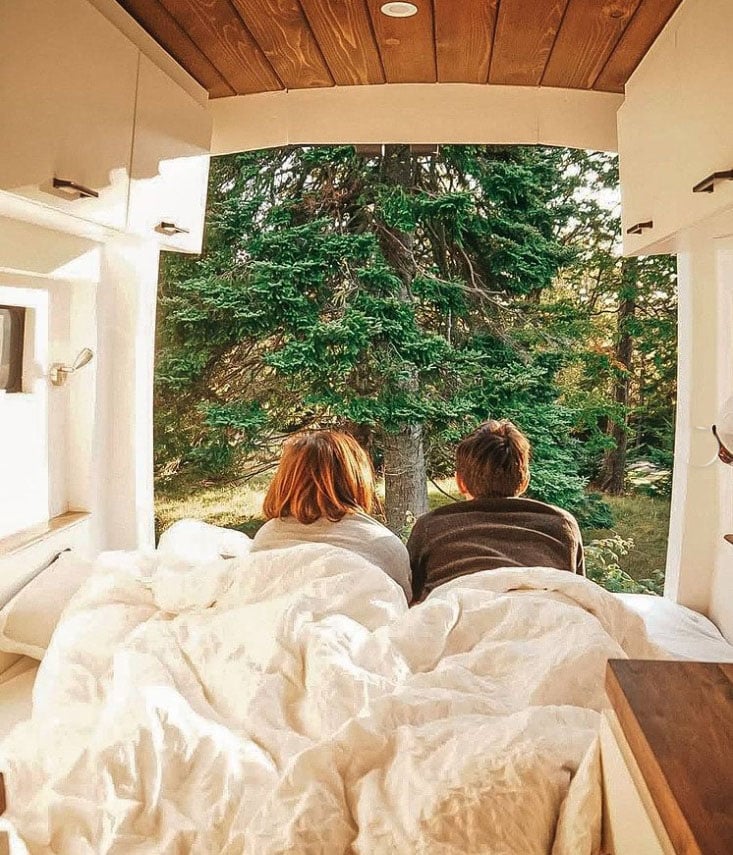
Couch-to-Bed
In my first Sprinter van, the convertible bed was across from the slider door, creating a sofa that looked out the door to a wide-open view. It was basically half of a dinette. When I was traveling solo, I could stow the table and the couch was large enough that I didn’t even have to pull the bed out, so that was a plus. What I didn’t like about it was when the bed was in bed form, it took up the entire area next to the slider door.
When my partner was traveling with me, if we didn’t have the exact same sleeping schedule, there wasn’t really anywhere else to go when the other person was sleeping and moving from the front of the van to the back of the van required climbing over the bed. You can see more in this video of the bed in my first Sprinter van
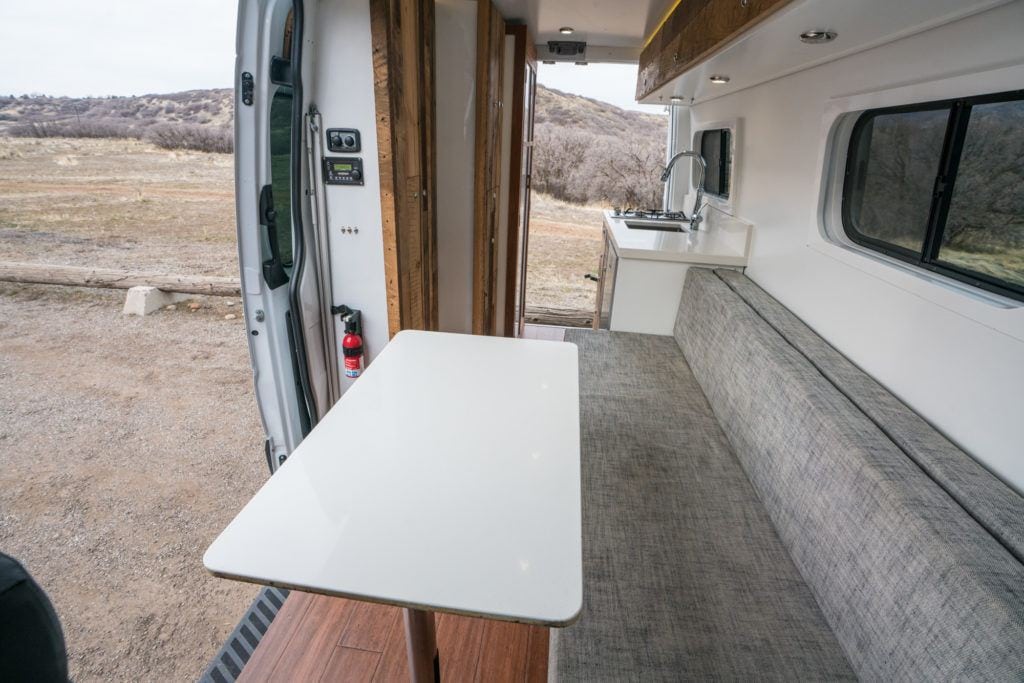

What type of bed are you building in your van? Share your questions, tips, and experiences down in the comments, and be sure to sign up for our van life newsletter!

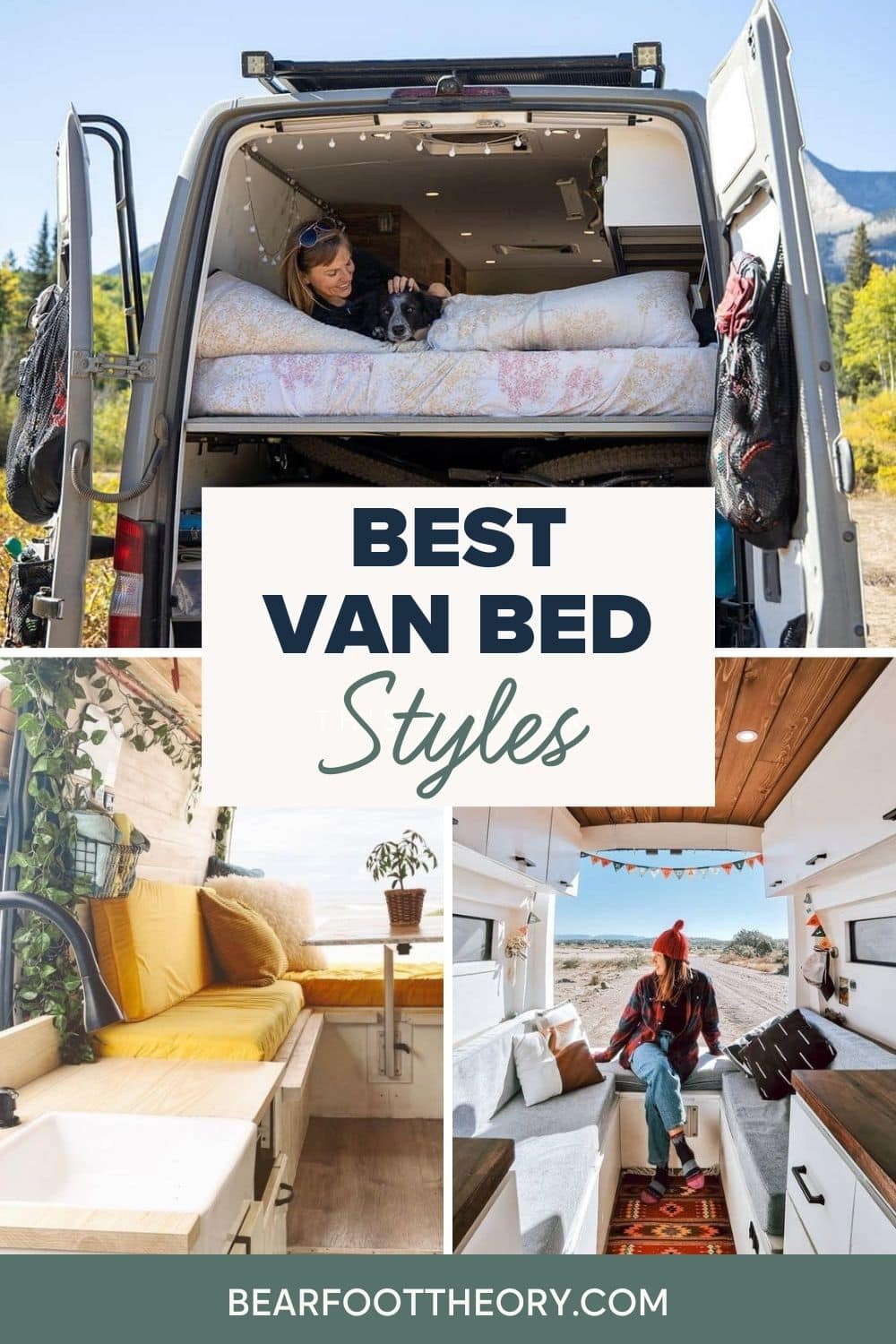
Question on platform beds.
What is the max height you should or can be, in order to plan on sleep crosswise in a sprinter without flares?
Hi Debra – The interior width of Sprinters and Transits is around 5’5″ once the insulation and paneling are installed. So if you’re shorter than 5’5″, you might be able to sleep comfortably crosswise without flares.
Hiya! Thanks for all the great info! I’m converting a Sprinter into a living space so I want a very comfy, permanent bed. I don’t want to do the pop outs, due to cost restraints, but that means the width of the van is 70″ wide after build out. Since the standard twin bed is 75″ this means I’ll need to purchase a custom mattress. Since I’m spoiled rotten with my current tempurpedic mattress, going to a piece of foam or futon would be torture. Is there someone out there who makes a super comfy tempurpedic “type” custom mattress? Any suggestions will help! Thanks so much!
Karen
I haven’t come across anyone who makes a custom Tempurpedic mattress, but that’s not to say it isn’t out there!
I have not done more than look briefly at the website but a friend of mine is interested in this Froli travel bed: https://nickleatlantic.com/products/froli-travel-modular-bed-system?variant=709845999
It looks like it might be a good compromise between a thick piece of foam and a ‘real’ mattress since you have a layer of springs that you top with a foam pad of the density you desire.
Where I live , there is a business called Jamestown Mattress that will custom make one
Hi Kristen
Do you have any recommendations for low profile mattresses?
Thanks
Hi Tom – we don’t have any specific recommendations for low profile mattresses.
I just found and purchased a 1974 dodge camper van so want to update.So the bed be the first.Thanks for your knowledge. Like to know were best place to get on low budget . Thanks again
I’m very interested in get started in van life but ofcourse live in a very cold winter climate. Info need and appreciative
We have a post about Van Life in Winter that you might find helpful!
Another bed option is a ‘swallow tail’ format. Beds that are joined about 4 feet from the back, but then angle to meet up with cabinet widths. A step at the 4foot area allows getting into and out of bed without crawling, or disturbing. This also allows easy access storage under the two sections ( below where feet and legs are). Out step also has storage. Love ours.
Jack-knife sofa would be #8. It’s a bed, no wait it’s a sofa.
I installed a queen bed on a floating platform that electrically raises to the roof and lowers to “normal” bed height with full range of adjustment between to accommodate different sized bikes, an appliance, or just skis. You can see more of this in the video “Van LIfting Bed details” on my channel. Works simply, quietly and raises and lowers within half a minute with pre-set height adjustment. Also lifts, holds and lowers 1600 pounds so plenty strong for two people.
We created a murphy bed based on the one designed by the dwnshifters blog. It comes down from the side rather than the rear of the van and allows you to store your linens and pillows in it at night so you don’t have to make and unmake the bed every day.
Hey Karen,
Tempurpedic is a memory foam… you can cut it!
Now you only need to customize your sheets, and there are little straps you can get at Bed Bath & Beyond/ Walmart etc to hold the sheets on. Enjoy!
Really helpful information
It’s good to list all the companies who sell particular type of bed. Maybe even with price to build or buy.
Also I would like to here about pros and cons for a slatted bed option like this one. https://van2b.com/product/ford-transit-van-murphy-bed/
Lift bed it’s a convertible bed? No need to setup every day. But what are the cons there?
Hi Tim – I don’t list specific beds because I don’t have personal experience in order to stand by the recommendation. I haven’t met anyone with the bed you linked to. I’d recommend joining the sprinter source forum and making a post in there to see if anyone has used this specific bed.
Hey I am thinking we want a convertible bed but I am not sure where to find the mattresses. I am thinking I want it to at least two separate pieces to turn into a pair of couches but I haven’t been able find anything like that. What are your sources for foam and the. How do I cover the foam?